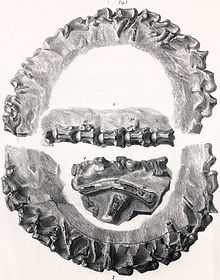Palaeophis
| Palaeophis Temporal range: Eocene | |
|---|---|
 | |
| Articulated vertebrae of P. toliapicus | |
| Scientific classification | |
| Kingdom: | Animalia |
| Phylum: | Chordata |
| Class: | Sauropsida |
| Order: | Squamata |
| Suborder: | Serpentes |
| Infraorder: | Booidea |
| Superfamily: | Alethinophidia |
| Family: | Palaeophiidae |
| Subfamily: | Palaeopheinae |
| Genus: | Palaeophis Owen, 1841 |
| Species | |
| |
Palaeophis ('ancient snake') is an extinct genus of marine snake whose fossils have been found in England, France, Denmark,[1] Morocco[2] and Mali,[3] dating back to the late Paleocene and Eocene epochs. The species P. colossaeus, known from a single vertebra, was originally estimated to exceed 9 m (30 ft) in length,[3] making it one of the largest known snakes, however most species of the genus were not as big (e.g. P. casei being slightly over one metre).[4][5]
Biology
Palaeophis, like most members of its clade, was a specialised aquatic animal, occurring mostly on marine sites, though at least some estuarine remains have also been found. Its known species varied broadly in size; Palaeophis casei is the smallest at 1.3 metres of length, while Palaeophis colossaeus is the largest at the estimated size limits for the genus at over 9 m. Likely, individual species occupied a vast variety of ecological niches.
Studies on Palaeophis vertebrae show a high degree of vascularisation, suggesting that it had a considerably faster metabolism and growth rate than modern snakes. This may suggest that palaeophiids, like other marine reptiles such as mosasaurs, might had developed towards endothermy.[6]
References
- ↑ Kristensen, H. V.; Cuny, G.; Rasmussen, A. R.; Madsen, H (2012). "Earliest record of the fossil snake Palaeophis from the Paleocene/Eocene boundary in Denmark". Bulletin de la Société Géologique de France 183 (6): 621–625. doi:10.2113/gssgfbull.183.6.621.
- ↑ Houssaye, A.; Rage, J.-C., Bardet, N., Vincent, P., Amaghzaz, M., Meslouh, S. (2013). "New highlights about the enigmatic marine snake Palaeophis maghrebianus (Palaeophiidae; Palaeophiinae) from the Ypresian (Lower Eocene) phosphates of Morocco". Palaeontology 56 (3): 447–651. doi:10.1111/pala.12008.
- ↑ 3.0 3.1 Rage, J.-C. (1983). "Palaeophis colossaeus nov. sp. (le plus grand Seprent connu?) de l’Eocène du Mali et le problème du genre chez les Palaeopheinae". Comptes Rendu de l’Academie des Sciences, Paris 3 (296): 1741–1744.
- ↑ Holman, J. Alan 1982. Palaeophis casei, new species, a tiny palaeophid snake from the early Eocene of Mississippi. Journal of Vertebrate Paleontology. 2, (2), 163-166.
- ↑ Rage, Jean-Claude et al. (2003). "Early Eocene snakes from Kutch, Western India, with a review of the Palaeophiidae". Geodiversitas (India: Editions scientifiques du Muséum, Paris, FRANCE) 25 (4): 695–716. ISSN 1280-9659. Retrieved 12 May 2010.
- ↑ ALEXANDRA HOUSSAYE1, JEAN-CLAUDE RAGE, NATHALIE BARDET, PEGGY VINCENT, MBAREK AMAGHZAZ and SAID MESLOUH, New highlights about the enigmatic marine snake Palaeophis maghrebianus (Palaeophiidae; Palaeophiinae) from the Ypresian (Lower Eocene) phosphates of Morocco, Article first published online: 13 FEB 2013, DOI: 10.1111/pala.12008
| Wikimedia Commons has media related to Palaeophis. |
| ||||||||||||||||||||||||||||||||||